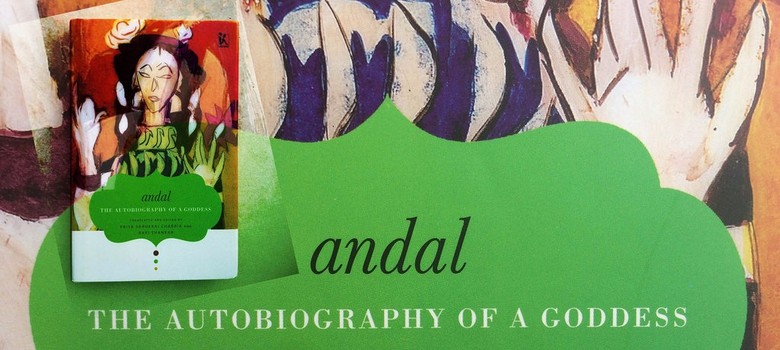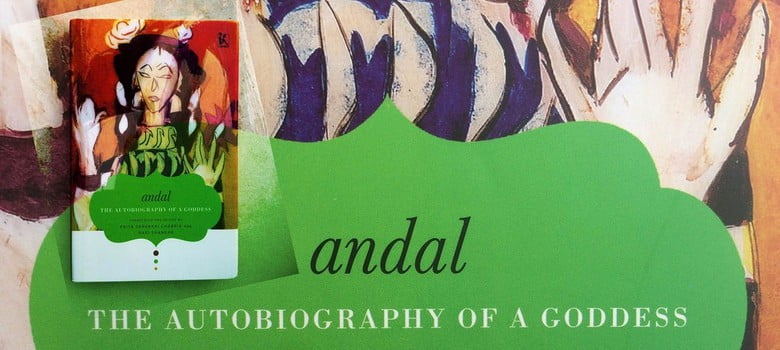
AK Ramanujan elucidated on translating the complex embedded worlds of akam – the inner landscapes of passion and love – and puram – the public domain of war and material reward. Among the formal issues he discussed particularly in akam is the ullurai, hidden signifiers or implied markers that anchor meaning and permit inner connections to float into understanding. Ramanujan has suggested the term “metonymous metaphor” for this kind of formal schema that “leaves out all points of comparison and all explicit markers of comparison”.
Used extensively in love poems, the eraichi, another concept intrinsic to Sangam poetics, is the implied meaning akin to an extensive system of metonyms. Derived from allusions to nature that do not necessarily have a systematic connection to what is being described, the employment of eraichi requires the poet to have a thorough understanding of the local flora, fauna and climate as well as their symbolism. For instance, the poet Kapilar named 99 flowers in a garland that the lovelorn heroine strung after bathing in a waterfall – where each flower suggested a subtly different nuance of love.
The ullurai, “inner substance”, however, is the parallel or substitute meaning that is inset in poems; it is an “implicit metaphor”. This often alludes to mythology and is to be divined through knowledge of context and codification. The ullurai becomes, as it were, a floating chamber of meaning trapped in the underwater roots of the poem that must be released – for the poem to blossom in the mind like a lotus opening at dawn.
Andal, a poet of exquisite allusions, used both poetic devices effortlessly. In verse one of Song Nine, (Cintura Cempoti) she mentions small red bugs, akin to ladybirds, swarming over green leaves. Beside the concreteness of the image, the emergence of these confounding red bugs evokes the onset of the monsoon, and consequently, the traditional time for men to return home from warfare and palace work to help in agricultural duties of sowing. Therefore it is the time for the lover to claim her in fecund wet surroundings – as ready as she is.
This “bugging” detail also suggests a possible pattern of blood droplets implying she is menstruating, a woman already. And this too: she waits impatiently, demanding her hymen be torn and she bleeds like rain falling over the earth as her lover, the supreme god, takes her. Here is a version that holds this cluster of embedded meanings:
Blood drops of ladybugs fluttering through moist sparkle
settle on lush land like a scatter of rubies flung
from skies reeling with rain – irradiating as my love
for him who covers me all over with his darkness
Nacciyar Tirumoli is a work of layered suggestion and unambiguous wild passion wedded to an overwhelming enchantment with the divine. Andal’s unconditional surrender (prabati) to Narayana-Vishnu is of such intensity and anguish that she scolds and even rages against god while demanding his caress.
Other translations concentrate on expounding Srivaishnava philosophy, using the guidance of scholars and historians to illuminate the aforementioned aspects or render literal translations that exhibit remarkable fidelity to the original; we have attempted to do something very different.
We concentrate on the aesthetic properties of her songs, reimagining them as lyric poems and foregrounding the metaphoric and sensory valences of her words, while keeping the more esoteric and philosophic meanings in the background, informing but never conscripting us. Our translations are very much a poet’s translations, rather than a scholar’s.
Multiplicity of Translations
If one imagines each of Andal’s verses to be like a luminous underwater cavern, the devices of the eraichi and the ullurai would be like whorls of differently coloured water swirling within. The translations of Andal that we have read (and there are not many) and many fine translations of Sangam era poetry use one of two strategies for translating these verses:
1. footnote and annotate extensively to render mythological and inset allusions or provide a large section on notes to the poems;
2. expand each tight four-line stanza into a longer module to include these allusions. This results in meshing levels of resonance into one smooth, evenly coloured narrative.
For instance, Vidya Dehejia’s powerful translation of Hymn Eight (vin nilamelappu), verse nine, given below has Andal asking monsoon clouds to act as her messengers to the God of the Universe.
O rain clouds
rearing like dark elephants above the hill of Venkata
the word of the lord
who slumbers upon the serpent has turned false.
Forgetting that he is
my sole refugee,
he tortures
the young maiden.
If the world hears of it,
will they speak well of him?
In order to catch the allusions, you need the context, which Dehejia brilliantly provides, but in our translations, we have opted to include the context within the poem itself, compressing the connotative with the denotative by developing our own distinctive method of coping with the levels of evocation in Andal’s work.
Below is Priya’s translation of the same verse that Dehejia has translated, which demonstrates the very different techniques that we are employing in this book. Immediate associations and meanings are bracketed in the word-for-word translation.
madayanaipol yezhundha mamygul kaal vengadatthai
padhiyaga vaazhveergal/paambuannaiyan vaarthaiyenne
gathi yenrum than aavan karundhadhu or penkodiyal
vadai shendan yennum shol vaiyagatthar madhiyarey
Literally, the verse translates thus:
rut-mad elephants (fighting) (resembling) rearing vast (monsoon) clouds trumpeting about Vengadam high above base, (forested) greetings. Serpent (endless time, coiling, huge) reclining on (his) words (to me) great person who protects all (I) surrender, will he not think of a girl-vine (slender, tender, trusting) tormenting (me) promises (not kept) saying, people (him) respect will not (he should save his reputation)
Priya has taken this and created a triptych that attempts to move from the literal to the eraichi to the ullurai. The first version is closest to her literal utterance.
In the second, the parallel, Priya peels Andal’s erudite mythological allusions and nature’s signifiers for landscapes become metonyms of inner vistas of love and longing.
The third, the inset, is the most free: in the hidden level Priya discovers Andal is explicit as she commands divinity to inhabit her pulsating corporality. This demanding third leap has often “arrived” piercingly, as an inversion of the literal meaning.
Andal says:
Great thunderheads rearing like maddened
War elephants over Vengadam’s forested emerald
Summit ask him who makes his bed on the colossal
Coils of the sacred serpent what words he said to me.
He, Protector of the Universe, sole refuge to all is false
With me, a maiden slender and trusting.
In what light will the world judge him if he betrays
Me, slays me instead? Shouldn’t he protect his name?
She also says:
Clouds clashing like rutting elephants trumpeting with trunks entwined over Vengadam’s peak
ask him who sleeps on the snake’s stupendous loops to awaken to my distress, to be not twisted
in his words. He, Supreme Guardian of All ignores me as he slumbers, head secure beneath its hood.
I blossom in love, a vine yearning to wrap around him. How
will universes assess him if he lets me wither?
Perhaps she says this too:
coiled twisted thunderheads coiled twisted words of succour ask me
tender coiling vine what words of love should be
save yourself resplendence
by loving me
my love expanding over universes expanding
Taken together, the three versions of the poem move from the outer word to the inner world, and it is a kind of composite that allows the hidden power, manifest lyricism and colloquial address all to emerge together so as to approximate what is contained in Andal’s original version.
While this from Song Twelve, Take Me to His Sacred Places, was Priya’s response to Andal’s splitting of location and urge in each verse:
Vast dark clouds, flowers burning amethyst as his eyes and sapphire
as his body, lotuses tender as his skin urge: “Go to him!
Go!” to Hrisikesa who though chief among gurus waited sweating,
belly pinched in hunger. He waited long for his share
of sacrificial food at Bhaktilocana.Take me now to that sacred grove. I’m hungry, I’m rapture’s offering,
his food, he’s mine to devour.
Ravi, on the other hand, has evolved a poetics of spirituality that runs consistently through his distinctive worlding of Andal’s yearning; he abridges, uses ellipses and flights of the imagination to net and clothe her in words. This excerpt is from his Tiruppavai:
He is the peacock of the woods, who brightened
his mother’s womb and whose very skin is supple
as a cobra’s hood, glistening as if basted in almond
oil and we just can’t look away.May our past crimes burn, let those yet to come
burn and turn to ash, know us only as we are before
you now, cowgirls bathing in what pours from above,
what rises from below to soak us.Do you not hear dear friends how the birds chirrup,
how resonant the conch sounds from the temple
of Garuda’s lord? It pervades the air with his name –
Hari. Hari. Hari. Hurry.
Or this, from Nacciyar Tirumoli, Song Ten, Dark Flowers:
O black cuckoo what ravaged garden girds
your song? Whirr plaintively instead a blue-
note for the one with a fluttering banner
on an immaculate field who alone
holds the purpose of my life as mere song in his paws
that we will both hear to vanish with us.
Or this, from Dark Clouds Be My Messenger:
Wine-dark clouds, massed ready for monsoon,
Batter the name of my beloved on Vengadam,
for valiant in battle, he is finally ready to put
down his arms and come home to be with me.
Tell him like the scrolls of leaves that fall unread
after prolonged rain has stripped the branches,
I too waste away, unread, waiting for the day
he might translate the secret letters of my limbs.
Ravi attempts to refined a line possessed of a geometric intricacy that can speak to the tension between divine order and disorder, while Priya has evolved a strategy that will permit the swirling whorls of eraichi and ullurai to manifest, each with its unique iridescence, edge, expansion and inflection, so that the body of each translated verse retains its multi-hued complexity and extends the expansive reader receptivity Andal demanded.
Priya’s versions of the poems are full of pulsations that suggest the hidden and sacred transmutations of inner and outer worlds, while Ravi’s are less fragmented and more fluent.
Equally spiritual in affect, and complex in poetic sensibility, both translations, when set side to side, illumine a totality about Andal that neither one individually could capture.
Even though we both read and edited the work together, it is because of the polyvalence of Tamil poetry generally, and Andal’s work specifically, that we’ve chosen to employ this strategy of including multiple versions of the same poems. This methodology, unique among works of translation, attempts to get at both the philosophical and literal underpinnings of her work.
Such multiple versioning is risky; it could also become merely of academic interest. But perhaps the distinctive allusiveness that leaps out at each level of exploration will be retained and echo into the next like a shimmering streak of colour dissolving.
Excerpted with permission from the section ‘Translators’ Note’ from Andal: The Autobiography of a Goddess, Translated and Edited by Priya Sarukkai Chabria and Ravi Shankar.
[“source-Scroll”]





